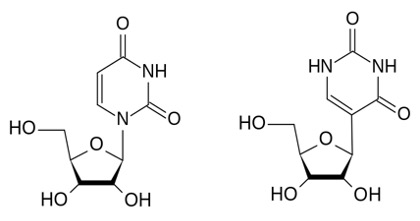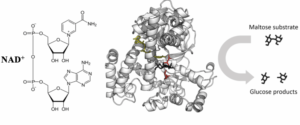
Figure 1: The image on the left displays a standard N-nucleoside, one of the naturally occurring building blocks of RNA. The image on the right depicts the far more biochemically useful C-nucleoside. Since the C-nucleoside is so desirable, scientists have been researching ways to synthesize these molecules efficiently
Source: Wikimedia Commons
The COVID-19 pandemic has unleashed an intensive search for therapeutics and vaccines. Researchers have explored many biological avenues, which has increased interest in various substances whose medicinal value may have been overlooked in the past. One such molecule that has recently garnered attention is the nucleoside, which acts as a structural subunit of DNA or RNA. Nucleosides are composed of a base, either a purine (adenine or guanine) or a pyrimidine (cytosine and thymine if DNA or uracil if RNA), as well as a five-carbon sugar, either ribose (if RNA) or deoxyribose (if DNA) (Biology Online, 2020). Nucleosides are related to nucleotides, the primary building block of DNA and RNA, but the chief difference between them is that a nucleoside lacks a phosphate group. What makes nucleosides intriguing for scientists is the specific bond between the base and five-carbon sugar.
Differences in the bonds between the base and the sugar leads to two different classes of nucleosides — nitrogen (N)-nucleosides and carbon (C)-nucleosides (Graz University of Technology, 2020). N-nucleosides, which are the more naturally occurring building blocks of RNA, link the sugar to the carbon base using a carbon-nitrogen bond. On the other hand, C-nucleosides utilize a carbon-carbon bond. For the field of medicinal chemistry, C-nucleosides are much more biochemically useful than N-nucleosides due to their extra hydrogen group. Some of its benefits include thermal stability and the ability to give active ingredients a prolonged biological half-life. (Penzo et al., 2017).
Previously, medicinal chemists utilized chemical synthesis to create C-nucleosides, but this is an incredibly complex and inefficient method that utilizes toxic chemicals. To increase efficacy and eliminate the need for toxic chemicals, Bernd Nidetxky at the Graz University of Technology and Martin Pfeiffer from the Austrian Centre of Industrial Biotechnology pioneered a method of utilizing catalysts to produce C-nucleosides using the enzyme ‘YeiN’ (Graz University of Technology, 2020). The overall reaction mechanism is rather complicated — starting with a simple ribose sugar, and proceeding ultimately to the C-nucleoside that matches the N-nucleoside pseudouridine. The role of YeiN in this mechanism is to link up the uracil-like component (one nitrogen atom replaced with carbon) to the ribose sugar by a carbon-carbon bound. As Bernd Nidetxky explains, the efficiency and catalytic power of YeiN makes the “biocatalytic production of C-nucleosides a very strong, elegant alternative to classical chemical synthesis” (Graz University of Technology, 2020). Previous methods of synthesizing the C-nucleoside, as Nidetxky suggests, were more demanding and expensive.
In a continuation of their research, the two researchers produced several derivatives of the valuable C-nucleoside. Furthermore, they demonstrated that one of those derivatives could be incorporated into RNA, which enables the modification of RNA. Its discovery has only become more relevant as scientists look to RNA-based therapeutics to solve the world’s pandemics. The increase in stability and longer half-life of C-nucleosides make for an appealing solution. In fact, one such C-nucleoside derivative is the drug Remdesivir, which possesses crucial antiviral properties (Graz University of Technology, 2020). This drug, which has been proven to be effective against many RNA viruses, including both the coronavirus and the Ebola virus, has received approval in the European Union for the treatment of COVID-19 patients.
As C-nucleosides’ valuable functionality begins to gain popularity, Bernd Nidetxky and Martin Pfeiffer hope to continue their research to expand the substrate spectrum of YeiN (Graz University of Technology, 2020). They believe that this will yield the biocatalytic synthesis of further C-nucleosides and eventually result in further relevant applications. Additionally, the two researchers anticipate that the increased efficacy in the production of C-nucleosides could provide a much needed impetus for the research into RNA therapeutics, which would dramatically advance our capabilities to fight the next deadly virus.
References
Biology Online. (2020, July 05). Nucleoside. Retrieved December 27, 2020 from https://www.biologyonline.com/dictionary/nucleoside.
Graz University of Technology. (2020, December 15). RNA basic building block produced biocatalytically for the first time. ScienceDaily. Retrieved December 27, 2020 from www.sciencedaily.com/releases/2020/12/201215121157.htm.
Penzo, M., Guerrieri, A. N., Zacchini, F., Treré, D., & Montanaro, L. (2017, November 1). RNA Pseudouridylation in Physiology and Medicine: For Better and for Worse. Genes, 8(11), 301. Retrieved December 27, 2020 from https://doi.org/10.3390/genes8110301.
Related Posts
A New Perspective on Treating Asthma
Figure 1: This diagram displays the results of tissue remodeling...
Read MoreWhy Do We Really Need Vitamins?
Figure 1: This figure illustrates the interaction between an enzyme,...
Read MoreBispecific Antibody Recruits Vγ9+ γδ T cells for Leukemia Treatment
Figure 1: The image is taken from an elderly woman...
Read MorePalin Narsian



